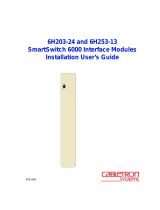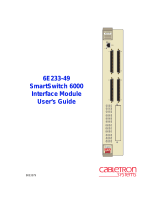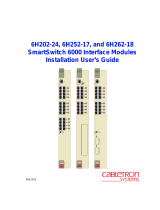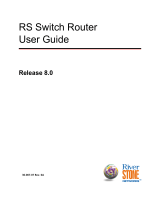Page is loading ...

9032267-04
SmartTrunk
User’s Guide


i
Notice
Notice
Cabletron Systems reserves the right to make changes in specifications and other information
contained in this document without prior notice. The reader should in all cases consult Cabletron
Systems to determine whether any such changes have been made.
The hardware, firmware, or software described in this manual is subject to change without notice.
IN NO EVENT SHALL CABLETRON SYSTEMS BE LIABLE FOR ANY INCIDENTAL, INDIRECT,
SPECIAL, OR CONSEQUENTIAL DAMAGES WHATSOEVER (INCLUDING BUT NOT LIMITED
TO LOST PROFITS) ARISING OUT OF OR RELATED TO THIS MANUAL OR THE INFORMATION
CONTAINED IN IT, EVEN IF CABLETRON SYSTEMS HAS BEEN ADVISED OF, KNOWN, OR
SHOULD HAVE KNOWN, THE POSSIBILITY OF SUCH DAMAGES.
© December 1998 by:
Cabletron Systems, Inc.
P.O. Box 5005
Rochester, NH 03867-5005
All Rights Reserved
Printed in the United States of America
Order Number: 9032267-04
Cabletron Systems
and
FNB
are registered trademarks and
SmartSwitch
,
SmartTrunk
, and
SmartMIM-216
are trademarks of Cabletron Systems, Inc.
All other product names mentioned in this manual may be trademarks or registered trademarks of
their respective companies.

ii
Notice
FCC Notice
This device complies with Part 15 of the FCC rules. Operation is subject to the following two
conditions: (1) this device may not cause harmful interference, and (2) this device must accept any
interference received, including interference that may cause undesired operation.
NOTE:
This equipment has been tested and found to comply with the limits for a Class A digital
device, pursuant to Part 15 of the FCC rules. These limits are designed to provide reasonable
protection against harmful interference when the equipment is operated in a commercial environment.
This equipment uses, generates, and can radiate radio frequency energy and if not installed in
accordance with the operator’s manual, may cause harmful interference to radio communications.
Operation of this equipment in a residential area is likely to cause interference in which case the user
will be required to correct the interference at his own expense.
WARNING:
Changes or modifications made to this device which are not expressly approved by the
party responsible for compliance could void the user’s authority to operate the equipment.
VCCI Notice
This is a Class A product based on the standard of the Voluntary Control Council for Interference by
Information Technology Equipment (VCCI). If this equipment is used in a domestic environment,
radio disturbance may arise. When such trouble occurs, the user may be required to take corrective
actions.
Industry Canada Notice
This digital apparatus does not exceed the Class A limits for radio noise emissions from digital
apparatus set out in the Radio Interference Regulations of the Canadian Department of
Communications.
Le présent appareil numérique n'émet pas de bruits radioélectriques dépassant les limites applicables
aux appareils numériques de la class A prescrites dans le Règlement sur le brouillage radioélectrique
édicté par le ministère des Communications du Canada.

iii
Notice
Declaration of Conformity
Addendum
Application of Council Directive(s):
89/336/EEC
73/23/EEC
Manufacturer’s Name:
Cabletron Systems, Inc.
Manufacturer’s Address:
35 Industrial Way
PO Box 5005
Rochester, NH 03867
European Representative Name:
Mr. J. Solari
European Representative Address:
Cabletron Systems Limited
Nexus House, Newbury Business Park
London Road, Newbury
Berkshire RG13 2PZ, England
Conformance to Directive(s)/Product Standards:
EC Directive 89/336/EEC
EC Directive 73/23/EEC
EN 55022
EN 50082-1
EN 60950
Equipment Type/Environment:
Networking Equipment, for use in a
Commercial or Light
Industrial Environment.
We the undersigned, hereby declare, under our sole responsibility, that the equipment packaged with
this notice conforms to the above directives.
Mr. Ronald Fotino Mr. J. Solari
____________________________________________________ ______________________________________________________
Full Name Full Name
Principal Compliance Engineer Managing Director - E.M.E.A.
____________________________________________________ ______________________________________________________
Title Title
Rochester, NH, USA Newbury, Berkshire, England
____________________________________________________ ______________________________________________________
Location Location

Notice
iv

v
Contents
Chapter 1 Introduction
SmartTrunking...............................................................................................................1-1
Packet Distribution .......................................................................................................1-2
Compatibility - DEC Hunt Groups and
SmartSwitch Router (SSR).................................................................................... 1-3
Chassis with Multiple SmartTrunking Groups.........................................................1-3
SmartTrunk and Port Connections.............................................................................1-4
Getting Help ..................................................................................................................1-7
Chapter 2 SmartTrunk Configuration
SmartTrunk Configuration Rules................................................................................2-1
SmartTrunking Configuration Screen........................................................................2-3
Exiting the SmartTrunking Configuration Screen.............................................2-6
Appendix A Helpful Hints for Configuring SmartTrunk
Creating a Second Trunk Group ................................................................................A-2
Removing an Entire Trunk Group.............................................................................A-3
Removing a Port from a Group..................................................................................A-3
Appendix B MIBII Logical Interface Behavior
Logical/Virtual Port .....................................................................................................B-1

Contents
vi

1-1
Chapter 1
Introduction
Traditional 802.1D Spanning Tree Bridges only allow one active data path
between any two switches; all other parallel data paths are in Standby or Blocking
mode. If one interface or path should fail, then the other interface automatically
comes out of Blocking mode and forwards all of the traffic. This is fine for
redundancy purposes. However, it is not the most efficient use of resources.
SmartTrunk, also referred to as SmartTrunking, is Cabletron Systems’
terminology for load balancing or load sharing. SmartTrunk provides the ability
to take full advantage of the network’s redundant bandwidth. SmartTrunk
divides network traffic across multiple ports in parallel to provide additional
throughput. The SmartTrunk application can be used with any of Cabletron
Systems’ switch modules (except ATM modules).
SmartTrunking
A physical port configured in a SmartTrunk Group must:
• Be connected in a point-to-point link (full-duplex is recommended)
• Be connected to a port that is also configured as part of a SmartTrunk Group
• Have Spanning Tree protocol enabled
Whenever a physical port is configured in a SmartTrunk Group, the port will send
proprietary protocol messages (see PLAP and LLAP information in the
Compatibility section). Once the two switches at opposite ends of the link agree
that the trunking state is enabled, the SmartTrunk Group is established. As
additional ports are identified as belonging to the same SmartTrunk Group, the
SmartTrunk Group is automatically reconfigured to take advantage of the
additional paths.

Introduction
1-2
Packet Distribution
Packet distribution is based on hardware family type:
SmartSwitch 6000
Packet distribution among the ports in the group is accomplished by adding the
last two bytes of the
destination
and
source
MAC addresses and then applying
the modulus operator to the sum using the number of active ports in the group.
The remainder, which falls into the range of the number of ports in the group, will
dictate which port will be used by the address. This gives a random distribution
of the packet load, but insures that the same destination-source flow always goes
out the same port. This alleviates the possibility of out-of-order packets.
SmartSwitch 9000
Packet distribution is accomplished by applying the modulus operator to the last
four bytes of the
destination
MAC addresses using the number of active ports in
the group. The remainder, which falls into the range of the number of ports in the
group, will dictate which port will be used by the address.
Modulus Examples
Ports contained in the trunk are labeled from zero (0) to one less than the number
of ports in the group. For example, if the physical ports in the group are
1 3 5 7 9, packet distribution would be based on the trunking port number
assigned. Trunking port numbers are 0 1 2 3 4.
The modulus operator divides the first number by the second number and yields
a whole number remainder:
(sum of addresses) modulus (number of trunk ports) = remainder
For example:
5 mod 4 = 1
(Four goes into five once with a remainder of one)
4 mod 5 = 4
(Five goes into four no times with a remainder of four)
The remainder is the useful number that will fall between zero (0) and one less
than the number of trunk ports. This remainder will dictate which trunk port is
used to send the traffic by matching it to the trunking port number.

1-3
Introduction
Compatibility - DEC Hunt Groups and
SmartSwitch Router (SSR)
SmartTrunking for the SmartSwitch 6000 and the SmartSwitch 9000 is based on,
and compatible with, DEC Hunt Groups. With the SSR adopting the DEC Hunt
Groups protocol, this will allow all Cabletron equipment to be trunked to each
other. (See firmware release notes for the compatibility of the individual image
selected.)
SmartTrunking and Hunt Groups are comprised of two protocols:
• Logical Link Aging Protocol (LLAP) - Assists in learning and aging.
• Physical Link Affinity Protocol (PLAP) - Monitors and maintains the trunking
states.
Chassis with Multiple SmartTrunking Groups
Figure 1-1 depicts a simple example of a network using Cabletron devices that
support SmartTrunk. In this example, a module supporting SmartTrunk in a
SmartSwitch 9000 chassis has multiple groups of ports using SmartTrunks. The
SmartSwitch 9000 module acknowledges both the SmartSwitch 6000 module and
the SmartSwitch 2200 chassis. Thus, the SmartSwitch 9000 module has “multiple
groups,” when viewing LM and NMS (Network Management Software) screens.
A group is defined as a trunk connection between a chassis and/or a standalone
switch. In Figure 1-1, the 2200 and 6000 each have one group of trunking with two
ports. The 9000 module has two groups with two ports in each instance.
SmartTrunk can be configured in a number of different ways. Links can be made
from multiple ports on a standalone SmartSwitch to one or more standalone or
individual chassis-based SmartSwitches. When trunking from a standalone
switch to a chassis-based switch, the trunk ports need to be connected to the same
board in the chassis.

Introduction
1-4
Figure 1-1. Chassis with Multiple SmartTrunk Groups Enabled
SmartTrunk and Port Connections
The SmartTrunk application dynamically determines network loops and is used
concurrently with the Spanning Tree protocol. The SmartTrunk application only
acknowledges its neighboring switches. If a user goes through several switch
hops, then loops back to the first switch hop (creating a loop), a common
connection between two switches (any two) will go into a Blocking state (see
Figure 1-2).
SmartSwitch 6000
Chassis
SmartSwitch 9000
Chassis
9H422-12
SmartSwitch 2200
Users
2E43-27
COM
PWR
CPU
Group A on the
SmartSwitch 2200
Both Groups
on the
SmartSwitch 9000
Group B on the
SmartSwitch 6000 Module
9C106
MIM
-216Smart
Users
Group A
Group B
Users

1-5
Introduction
Figure 1-2. SmartTrunk with a Network Loop
Path costs are considered by SmartTrunk when disabling a looped configuration.
SmartTrunk will place the higher path cost trunk group into a Blocking state.
Path cost will be calculated using the following equations:
Speed
The speed of the interface (typically in megabits). For example, 10, 100, or 1000
(see Table 1-1).
Table 1-1. Example Path Costs
Port Type Path Cost
10 Mb, Half Duplex 100
10 Mb, Full Duplex 50
100 Mb, Half Duplex 10
100 Mb, Full Duplex 5
SmartSwitch 6000
Chassis
SmartSwitch 9000
Chassis
SmartSwitch 2200
2E43-27
COM
PWR
CPU
9C106
SmartTrunk
connections
blocked
MIM
-216Smart
MIM
-216Smart

Introduction
1-6
Active Trunk Links
The number of links participating in the trunking group.
If all the ports in the trunking group are the same speed and configured to the
same duplex mode, the equation is:
1000
------
Path Cost x # of ports
If the ports in the trunking group are different speeds, the equation is:
1000
------
Path Cost 1 + Path Cost 2 + Path Cost 3 + Path Cost n...
Figure 1-3. A Redundant Standby Path for Trunking
Multiple trunks can also be established between chassis-based switches, but only
one group of trunk ports will be active. The trunked ports do not necessarily need
to be on the same module. A Blocking state for all ports in the Group in Standby
will be reflected on the SmartTrunking Local Management screen. In some cases,
the INB backplane will block.
Trunking
(Active)
SmartSwitch 9000
Chassis
SmartSwitch 9000
Chassis
Blocked
1
2
The active path is determined by
the lowest combined path cost.
The higher path cost ports will be blocked.
9H422-12 9H422-12

1-7
Introduction
Getting Help
For additional support related to this device or document, contact Cabletron
Systems using one of the following methods:
Before calling Cabletron Systems, have the following information ready:
• Your Cabletron Systems service contract number
• A description of the failure
• A description of any action(s) already taken to resolve the problem (e.g.,
changing mode switches, rebooting the unit, etc.)
• The serial and revision numbers of all involved Cabletron Systems products in
the network
• A description of your network environment (layout, cable type, etc.)
• Network load and frame size at the time of trouble (if known)
World Wide Web http://www.cabletron.com/
Phone (603) 332-9400
Internet mail [email protected]
FTP ftp://ftp.cabletron.com/
Login anonymous
Password your email address
To send comments or suggestions concerning this document, contact
the Cabletron Systems Technical Writing Department via the following
email address:
TechW[email protected]
Make sure to include the document Part Number in the email message.
When this configuration is used, only one module’s SmartTrunk Group will be
active. The second path will block and serve as a backup to the currently active
path. (The active trunking path will be determined by the module providing the
lowest path cost.)
Refer to the release notes for image-specific restrictions while using
SmartTrunking.
The only time path cost is calculated is when a port is added or removed from the
trunking group. While the trunking group is operational, losses of link or PLAP
on a port will not result in path cost recalculation. In order for a redundant group
to become active, the entire primary group must become inactive or disabled.
NOTES

Introduction
1-8
• The device history (i.e., have you returned the device before, is this a recurring
problem, etc.)
• Any previous Return Material Authorization (RMA) numbers

2-1
Chapter 2
SmartTrunk Configuration
Prior to entering information in the SmartTrunking Configuration Screen, you
should understand the concept of SmartTrunk (see Chapter 1) and the
SmartTrunk Configuration Rules.
SmartTrunk Configuration Rules
The following rules apply when configuring ports for SmartTrunking.
1. There is a limit of six (6) SmartTrunk groups per switch. There are no port
number restrictions per group.
2. SmartTrunking ports should be configured to Full Duplex.
3. You cannot loop front panel ports back to the same module, to the same
chassis, or to different modules within that chassis.
4. You must enable Spanning Tree before you enable SmartTrunk If a network
loop exists and SmartTrunk becomes disabled, then as long as Spanning Tree
is enabled, the Spanning Tree algorithm will respond and block the necessary
ports.
5. If a network loop exists and SmartTrunk becomes disabled, and Spanning
Tree is also disabled, then an infinite packet loop may occur and adversely
affect the network.
6. If a SmartTrunking port becomes unusable, all traffic is redirected over the
remaining port(s) in the group.
Failure to follow these rules will produce poor network performance.
NOTE

SmartTrunk Configuration
2-2
7. Backplane ports (INB, FNB, FTM, etc.) on chassis-based switches cannot be
configured as SmartTrunk ports and are not eligible to participate in trunking.
8. An end station plugged directly into a port configured for SmartTrunking will
not be allowed to communicate. No traffic will flow into the port.
9. The same SmartTrunk group
cannot
be split onto two separate modules (see
Figures 2-1 and 2-2).
Figure 2-1. ILLEGAL CONFIGURATION (Example 1)
9H422-12
Group A
9H422-129H422-12

2-3
SmartTrunk Configuration
Figure 2-2. ILLEGAL CONFIGURATION (Example 2)
SmartTrunking Configuration Screen
To select the SmartTrunking Configuration Screen from the Module
Configuration Menu:
1. Use the arrow keys to highlight the SmartTrunking Configuration option.
2. Press the
ENTER
key. The SmartTrunking Configuration Screen, Figure 2-3,
displays.
9H422-12
Group A
9H422-12

SmartTrunk Configuration
2-4
Figure 2-3. SmartTrunking Configuration Screen
The following section briefly explains each field on the SmartTrunking
Configuration Screen.
SmartTrunk Group
The title of the group that is active in the screen.
SmartTrunk Logical Port
SmartTrunk ports are a collection of physical ports. When the logical port is not
one of the physical ports contained in the group, a MIBII interface is created to
represent the Trunk group. These interfaces are added dynamically as each new
hunt group is created (see Appendix A for more information).
If the logical port is one of the physical ports, then it identifies the bridge port
number used by all members of the SmartTrunking group.
The interface gets its MAC address from the management port of the SmartTrunk
(usually the first port added). If this port is removed from the trunk, the next
port’s MAC address will be assigned to the interface.
2E42-27 LOCAL MANAGEMENT
SmartTrunking Configuration
Device Type: 2E42-27 Firmware Revision: XX.XX.XX
BOOTPROM Revision: XX.XX.XX
SmartTrunk Group:
SmartTrunk Logical Port:
Port State Port State Port State
---------------- ----------------- -----------------
SmartTrunk State: [ENABLED] Trunk Protocol: [ENABLED]
Add/Remove Group: Group: [ ADD ]
Display Group: Port: [REMOVE]
SAVE UPDATE EXIT RETURN
/









